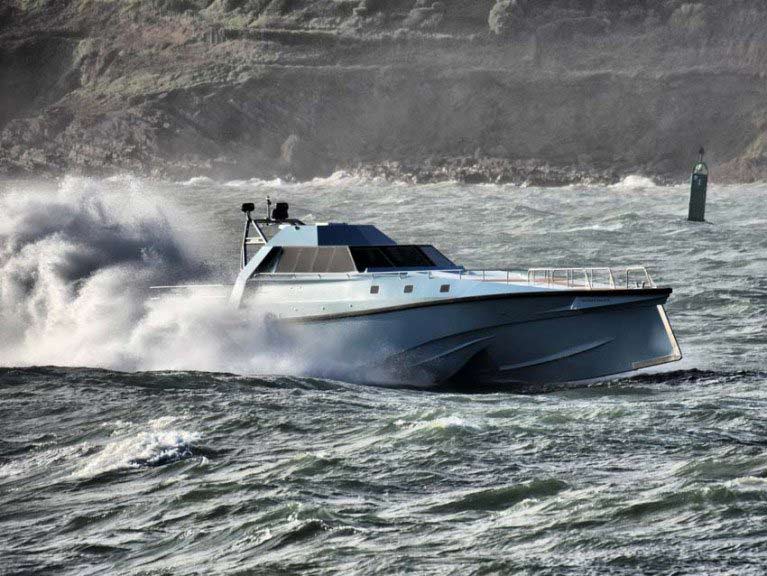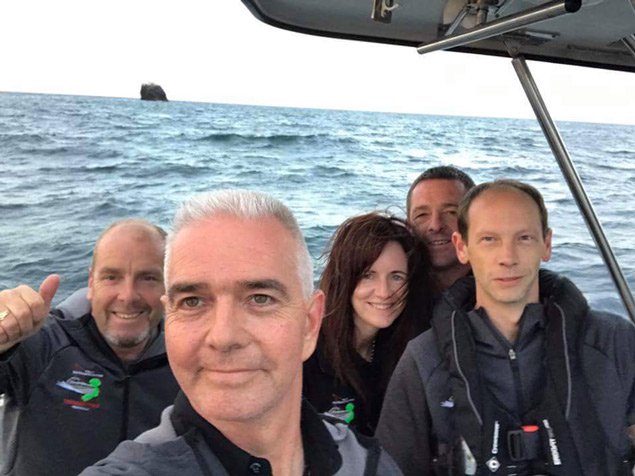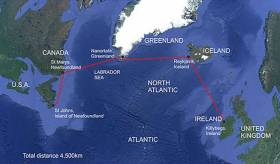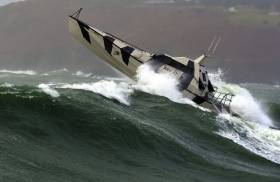Displaying items by tag: Thunder Child
The North Atlantic Challenge by Safehaven Marine of Youghal’s new 70ft XSV20 Thunder Child II was originally scheduled to be underway in mid-July this year. But although the boat had her preliminary launch in February, pressure of work on other craft in the company’s internationally successful pilot and patrol boat ranges at the busy factory has seen a postponement of the Challenge until 2020. And while the preferred strategy is still in favour of the northern route, the plan now is to do it west to east.
The revised programme is outlined in the following statement:
“Safehaven Marine’s ambition for 2020 is to set a new UIM-approved Transatlantic World Record from the North American continent to Ireland. Traditionally there are three main routes possible. The first is a direct route from New York to the West coast of Ireland. This is the shortest route but it is a distance of 2,600nm with a leg of 1,670nm across the Atlantic. This leg would require a fuel capacity that is not possible in a vessel of our size factoring our cruise speed (40kts) or mid ocean refuelling, not allowed by the UIM.
The second is from New York to the Azores, Portugal then Ireland. Although the longest leg across the Atlantic is less, at 1,300nm it is still beyond our range, and would be the greatest distance overall at 3,650nm. The third option is the Northern route, starting from Newfoundland, then Greenland, Iceland and down to the North West coast of Ireland. This route is the only real option open to us as the longest open ocean leg between refuelling points is 758nm, reasonably comfortably within the maximum range of Thunder Child II, and the total voyage is 2,400nm (4,500km)”
 The first XSV 20 Thunder Child II makes her debut on Cork Harbour in February 2019
The first XSV 20 Thunder Child II makes her debut on Cork Harbour in February 2019
Home Well Before Dark for Thunderchild
Apart from two essential stops at Portrush in County Antrim and Ballyglass on Broadhaven in County Mayo to take on fuel, Safehaven Marine’s challenge for a viable record for the 2000 kilometres round Ireland and Rockall, powering on with their remarkable new speed machine Thunderchild, has seen only two other stops writes W M Nixon.
One was to get a photo of the boat at Rockall itself last night, when enough daylight was available at the edge of the short northern darkness to produce a memorable and otherworldly image. And the other, specially important to a crew so closely involved with sea safety, was a pause at Black Rock off the Mayo coast this afternoon to pay their respects to the memory of the crew of air-sea rescue helicopter R 116, tragically lost on a March night four months ago in conditions very different from the summer weather which has now settled over Ireland.
But as this calm weather has followed on an unsettled period, the seas have taken time to smooth down. It’s seldom enough that Thunderchild has been able to enjoy a top speed of 52 knots in a voyage which at one stage saw her slowed back – albeit very briefly - to 20 knots. At 1845 hours this evening (Wednesday) she is at 42 knots coming in past the Fastnet, well on track to set a good time when she completes the circuit at the Old Head of Kinsale with an average speed of better than 33 knots, and neatly on time for a proper welcome home to Cobh well before dark.
 It has to be the ulltimate selfie – Frank Kowalski of Safehaven and his crewmates on Thunderchild with Rockall looking very small for a place which could be of great maritime economic significance.
It has to be the ulltimate selfie – Frank Kowalski of Safehaven and his crewmates on Thunderchild with Rockall looking very small for a place which could be of great maritime economic significance.
Frank Kowalski’s team from County Cork’s Safehaven Marine with their futurstic record-maker Thunder Child now have Rockall well astern in their counter-clockwise Round Ireland and Rockall Record bid writes W M Nixon.
After their first re-fuel on Ireland’s north coast yesterday afternoon, progress inititally was good, heading out toward the lone rock far into the Atlantic. But for a while this morning, in heading back to Ireland’s west coast, unfavourable condition slowed them back to 20 knots where the top speed since leaving the Cork coast has been 52 knots, with an average of 30.
However, the further they get from the Rockall bank, the smoother is the going, and at 0840hrs this morning they were back up to 36 knots and on track for the second re-fuelling stop at Ballyglass Pier in Broadhaven in far northwest Mayo around lunchtime. At time of writing, they have covered 1264 km in 22 hours 40 minutes at an average of 30 knots.
Thunder Child Takes On Storm Doris In Cork Harbour
#ThunderChild - Storm Doris’s high winds on Thursday (2 February) made the perfect conditions for testing Safehaven Marine’s latest state-of-the-art naval patrol vessel in Cork Harbour, as the Irish Examiner reports.
Test pilot Ciaran Monks was at the helm of Thunder Child amid 50-knot winds and six-metre waves in what crew member Mary Power said were “by far the roughest conditions she’s encountered since her launch before Christmas”.
As previously reported on Afloat.ie, Thunder Child was launched for tests in December in preparation for an attempt to break the record for the fastest circumnavigation of Ireland — with an open-sea loop via Rockall to boot.
The Irish Examiner has more on the story HERE.
Safehaven Marine's sleek Thunder Child interceptor tackling 6m waves in 50knt winds at the mouth of #Cork Harbour today #StormDoris pic.twitter.com/2yj8tZIuOx
— Eoin English (@EoinBearla) February 2, 2017
Safehaven’s ‘Thunder Child’ Put Through Its Paces In Stormy Cork Harbour
#ThunderChild - Stormy winter seas made the perfect proving ground for a new state-of-the-art naval patrol and rescue vessel tested in Cork Harbour recently, as the Irish Examiner reports.
But it’s just the beginning for Thunder Child – the latest high-tech design from Cork-based Safehaven Marine, makers of the James Bond-style Interceptor, Barracuda – which was launched from the Port of Cork last month.
Safehaven’s managing director Frank Kowalski has his sights set on breaking the record for the fastest circumnavigation of Ireland — including a 1,000km open-sea loop around Rockall.
And considering the sleek wave-cutting vessel has already clocked speeds of over 100kph in testing, and is kitted out to handle the stormiest situations, it should be well up to the task of that challenging route.
The Irish Examiner has more on the story HERE.
































































